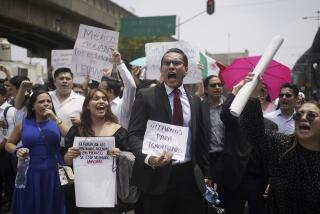Mexico’s Future Rides on Efforts to Reform Its Banking System
- Share via
MEXICO CITY — The government’s package of reforms to revive the sickly banking industry, the acknowledged weak link in Mexico’s economic recovery, is becoming a litmus test for the nation’s newly democratized political system.
The executive branch earlier this month sent to Congress a legislative package that would rewrite the way Mexico manages its financial system, including greater independence for the central bank and an end to restrictions on foreign investment in Mexican banks.
Finance Ministry officials are getting used to appearing constantly before committees of the lower house of Congress, which came under control of opposition parties for the first time in elections last July, to defend the package of proposals.
The measures are expected to pass sooner or later, but not without horse trading and amendments sought by opposition parties, which are determined to prevent the long-dominant Institutional Revolutionary Party from continuing to dictate every policy change in Mexico.
Effective legislative oversight, opposition deputies insist, will help avoid the hurried, ill-conceived financial reforms of recent decades that helped get Mexico into so much economic trouble in the first place.
No one disputes the immense scale of the banking crisis that arose after the December 1994 peso devaluation and severe recession that followed in 1995. Of the 18 Mexican banks that were privatized starting in 1991, 13 have either been taken over by the government or sold since 1994.
While shareholders lost fortunes, the government bailed out depositors by purchasing the assets of bankrupt and troubled banks, much like the U.S. savings and loan bailout of the 1980s.
*
Now the government’s bank rescue fund sits with a huge pool of 552 billion pesos--nearly $65 billion--in assets, many of highly questionable worth. Even after selling off the better assets, the cost of the bailout is expected to equal 14% of Mexico’s annual gross domestic product.
The surviving, recapitalized banks have just barely begun to resume any significant lending. Economists say greater access to capital is critical if Mexico is to continue its broad recovery, which since 1996 has been built on manufacturing exports (thanks to the weakened peso) rather than domestic economic activity. With the Asian crisis slowing world exports, healthier bank lending to spur domestic growth here is more vital than ever.
“We have managed to recover effectively from the crisis, but the demand for credit in the second half of this year and next year is going to be tremendous, and we need healthy banks to be able to respond to that demand,” said Victor Herrera, director-general of Standard & Poor’s in Mexico City.
Martin Werner, the Finance Ministry undersecretary who has engineered the financial reform package, said this week that his team was working virtually full time with Congress to explain the measures and get them approved.
He described the process as a “test of fire” for Mexico’s emerging political democracy as well as a central aspect of economic transformation.
Mexico has been beset by periodic crises since 1982 as successive PRI governments have brazenly overstimulated the economy at election time, usually with disastrous consequences. In 1995, after the peso lost more than half its value, inflation soared to more than 50% and unemployment more than doubled.
The new package of financial measures includes:
* Giving full control over exchange-rate policy to the Bank of Mexico, the country’s central bank. The bank currently shares that responsibility with the Finance Ministry, which has a tie-breaking vote. President Ernesto Zedillo also recently appointed former Finance Secretary Guillermo Ortiz to a six-year term as governor of the central bank, ensuring that Zedillo’s supporters will exert continued influence long after the elections in 2000.
* Giving more autonomy and power to the National Banking and Securities Commission to supervise the banking industry, in theory reducing the likelihood of further banking scandals like those that have helped sink several banks in recent years, most recently Confia. That Monterrey-based bank has now been bought by Citibank.
* Removing all limits on foreign investment in Mexican banks. Current law restricts outside investment in the biggest Mexican banks to 20%.
* Eliminating the bank rescue fund and creating two new separate bodies, one to sell off the bailout assets and the other to provide deposit insurance. Such insurance would be reduced from the current unlimited coverage to a ceiling of about $125,000, encouraging large depositors to be more diligent about the banks’ management of their investments.
*
Dolores Padierna, a deputy for the opposition left-of-center Party of the Democratic Revolution, said she expects the package to be approved in amended form--but not under duress from the PRI.
“We cannot afford to fail again,” she said. “There is a real need to achieve financial reform, but the banking crisis problem is too serious to act without thorough analysis.”
Her party will agree to consider the less-controversial aspects soon, including the central bank reforms, but the banking assets issue and foreign investment limits are more complex and may require a few months’ debate, she said.
More to Read
Sign up for Essential California
The most important California stories and recommendations in your inbox every morning.
You may occasionally receive promotional content from the Los Angeles Times.










